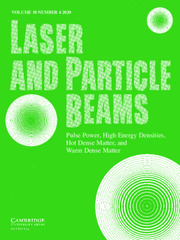Article contents
Self-induced transparency in plasmas with sharp boundary
Published online by Cambridge University Press: 09 April 2001
Abstract
We study fully relativistic nonlinear 1D fluid equations describing steady-state solutions for an electromagnetic wave interacting with plasma in the self-induced transparency regime. In addition to the well-known solution that corresponds to the transmission of the electromagnetic wave into plasma, another steady-state solution is shown to exist in a certain range of the amplitude of the wave. The latter one satisfies the same boundary conditions but corresponds to the full reflection of the incident wave. The co-existence of the two solutions indicates a rich structure of the interface between the opaque and transparent phases in ultraintense laser interactions with near-critical and overdense plasmas—in particular, one may expect hysteresis-like behavior when a current state of the system depends on its history.
Information
- Type
- ULIA-1 CONFERENCE PAPERS
- Information
- Copyright
- © 2000 Cambridge University Press
- 2
- Cited by

